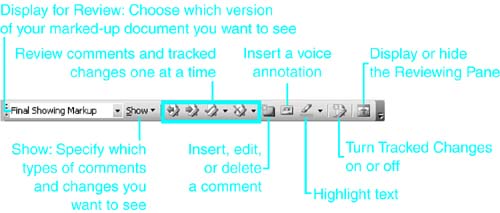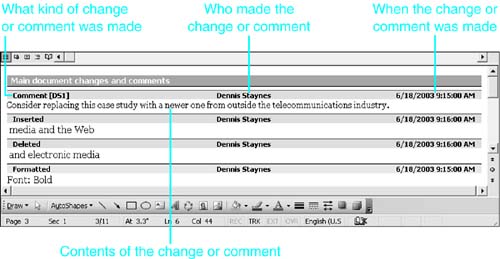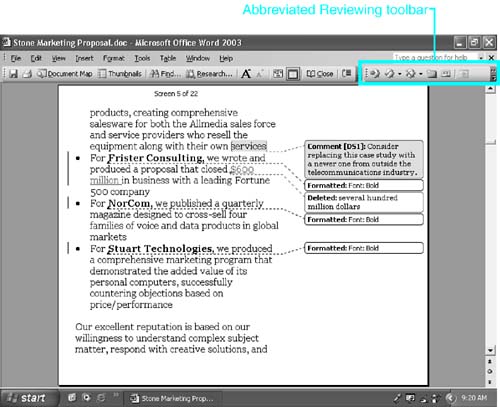Introducing Word's Reviewing Interface
The next several sections cover two of Word's core reviewing features: comments and tracked changes. In Word 2002, Microsoft revamped Word's interface to both features, making them significantly easier to use. If you are upgrading from an older version of Word, you may first want to get comfortable with Word's current reviewing interface before getting into the details of working with comments and tracked changes.
NOTE
Microsoft sometimes refers to comments and tracked changes collectively as markup.
Introducing Word's Reviewing Toolbar
Word's Reviewing toolbar brings together all commands for marking up a document with comments, tracked changes, and highlighting, as shown in Figure 26.2.
Figure 26.2. The Reviewing toolbar.

Two buttons on the Reviewing toolbar are especially worth mentioning: the Display for Review button and the Show button.
Display for Review allows you to control which version of your document you are looking at:
Final Showing Markup shows the document in its current form, with all comments and tracked changes marked so that you can see what changes have already been made. Insertions that have been made are shown within the document, and deletions are shown in balloons or the Reviewing pane.
Final shows the document in its current form, with no comments or tracked changes visible?in other words, the document as it would appear if you accepted every comment and tracked change.
Original Showing Markup shows the document in its original form but also makes all comments and tracked changes visible so that you can see what changes have been requested. Deletions are shown as strikethroughs within the document, and proposed insertions are shown in balloons or the Reviewing pane.
Original shows the document in its original form, with no comments or tracked changes visible?in other words, the document as it would appear if you rejected every comment and tracked change.
The Show button allows you to control several additional aspects of how your document displays material that must be reviewed.
By default, Word displays Comments, Insertions and Deletions, Formatting, and (if you are using a Tablet PC) any Ink Annotations you may have inserted. If the document is being reviewed by more than one person, by default, Word also shows each reviewer's changes at the same time. However, you can hide any or all of these items by clicking the Show button and clearing the corresponding check box (see Figure 26.3).
Figure 26.3. Choosing which sets of changes to display.

You might want to review formatting only after the document's content has been finalized; if so, clear the Formatting check box. Or you might want to review only comments from a single reviewer: Clear the All Reviewers check box and check only the name of the reviewer whose markup you want to see.
Working with Word's Reviewing Pane
Word's Reviewing pane (see Figure 26.4) makes it easy to scroll through all changes and comments made to the main document, headers and footers, text boxes, footnotes, and endnotes.
Figure 26.4. The Reviewing pane.

NOTE
The Reviewing pane replaces the Comments pane that appeared in versions prior to Word 2002 and did not display tracked changes.
To display the Reviewing pane, click the Reviewing pane button on the Reviewing toolbar.
As you enter comments or make changes with Word's Track Changes feature turned on, your comments and changes appear in the Reviewing pane. You can use the Reviewing pane's vertical scrollbar to move through comments and changes. If you want to review the context in which a certain change was made, click on the gray line containing a description of the change, and Word's main editing window displays the surrounding text.
Introducing Word's Reviewing Balloons
When you work in Print Layout view or Web Layout view, Word also inserts balloons in your document displaying comments and tracked changes (see Figure 26.5).
Figure 26.5. Word inserts text balloons marking comments and tracked changes.

Each reviewer's comments and changes appear in a different color. A dotted line points to the text being changed or commented on. When you click inside the balloon, the dotted line becomes solid. If you made the comment inside a balloon, you can edit it there.

Working with Reading Layout
You may find it easier to review a marked-up document in Word's new Reading Layout, which enlarges the text of your document for easy readability, while providing a large space at the right for balloons containing tracked changes and comments (see Figure 26.6).
Figure 26.6. Reviewing a document in Reading Layout.

TIP
If you work in Reading Layout view, you might find that the Reviewing toolbar is abbreviated to fit on the same row as the Reading Layout toolbar. To view all the options on the Reviewing toolbar, drag it below the Reading Layout toolbar.
Now that you've become familiar with Word's Reviewing interface, let's take a closer look at the reviewing features that use it: comments and tracked changes.







